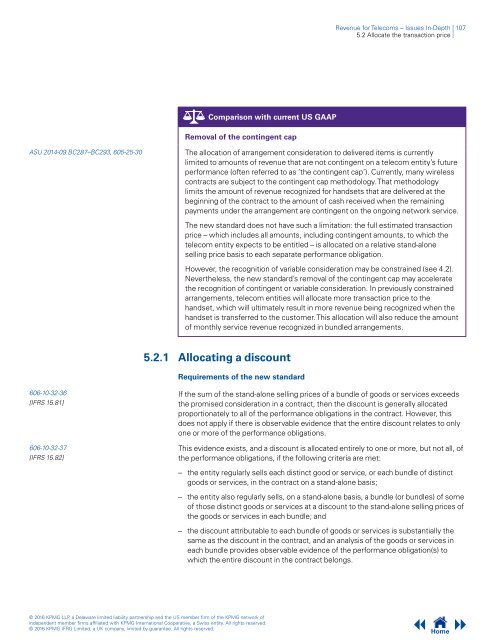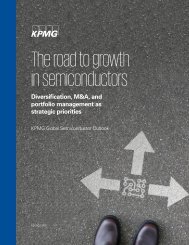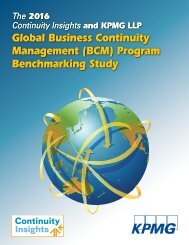Revenue for Telecoms
2cdncba
2cdncba
You also want an ePaper? Increase the reach of your titles
YUMPU automatically turns print PDFs into web optimized ePapers that Google loves.
<strong>Revenue</strong> <strong>for</strong> <strong>Telecoms</strong> – Issues In-Depth | 107<br />
5.2 Allocate the transaction price |<br />
Comparison with current US GAAP<br />
Removal of the contingent cap<br />
ASU 2014-09.BC287–BC293, 605-25-30<br />
The allocation of arrangement consideration to delivered items is currently<br />
limited to amounts of revenue that are not contingent on a telecom entity’s future<br />
per<strong>for</strong>mance (often referred to as ‘the contingent cap’). Currently, many wireless<br />
contracts are subject to the contingent cap methodology. That methodology<br />
limits the amount of revenue recognized <strong>for</strong> handsets that are delivered at the<br />
beginning of the contract to the amount of cash received when the remaining<br />
payments under the arrangement are contingent on the ongoing network service.<br />
The new standard does not have such a limitation: the full estimated transaction<br />
price – which includes all amounts, including contingent amounts, to which the<br />
telecom entity expects to be entitled – is allocated on a relative stand-alone<br />
selling price basis to each separate per<strong>for</strong>mance obligation.<br />
However, the recognition of variable consideration may be constrained (see 4.2).<br />
Nevertheless, the new standard’s removal of the contingent cap may accelerate<br />
the recognition of contingent or variable consideration. In previously constrained<br />
arrangements, telecom entities will allocate more transaction price to the<br />
handset, which will ultimately result in more revenue being recognized when the<br />
handset is transferred to the customer. This allocation will also reduce the amount<br />
of monthly service revenue recognized in bundled arrangements.<br />
5.2.1 Allocating a discount<br />
Requirements of the new standard<br />
606-10-32-36<br />
[IFRS 15.81]<br />
606-10-32-37<br />
[IFRS 15.82]<br />
If the sum of the stand-alone selling prices of a bundle of goods or services exceeds<br />
the promised consideration in a contract, then the discount is generally allocated<br />
proportionately to all of the per<strong>for</strong>mance obligations in the contract. However, this<br />
does not apply if there is observable evidence that the entire discount relates to only<br />
one or more of the per<strong>for</strong>mance obligations.<br />
This evidence exists, and a discount is allocated entirely to one or more, but not all, of<br />
the per<strong>for</strong>mance obligations, if the following criteria are met:<br />
– the entity regularly sells each distinct good or service, or each bundle of distinct<br />
goods or services, in the contract on a stand-alone basis;<br />
– the entity also regularly sells, on a stand-alone basis, a bundle (or bundles) of some<br />
of those distinct goods or services at a discount to the stand-alone selling prices of<br />
the goods or services in each bundle; and<br />
– the discount attributable to each bundle of goods or services is substantially the<br />
same as the discount in the contract, and an analysis of the goods or services in<br />
each bundle provides observable evidence of the per<strong>for</strong>mance obligation(s) to<br />
which the entire discount in the contract belongs.<br />
© 2016 KPMG LLP, a Delaware limited liability partnership and the US member firm of the KPMG network of<br />
independent member firms affiliated with KPMG International Cooperative, a Swiss entity. All rights reserved.<br />
© 2016 KPMG IFRG Limited, a UK company, limited by guarantee. All rights reserved.<br />
Home







